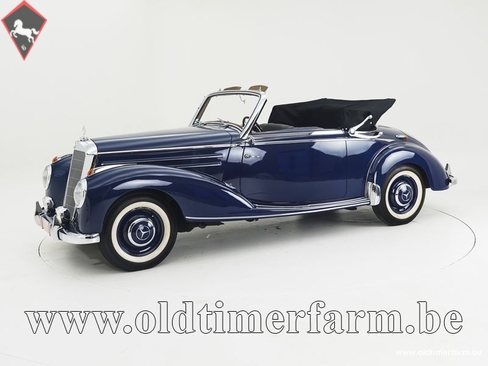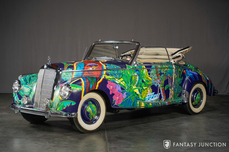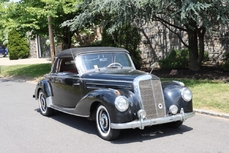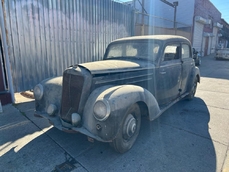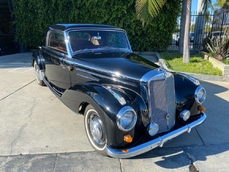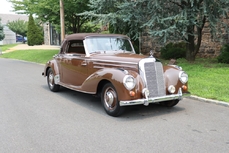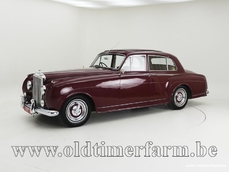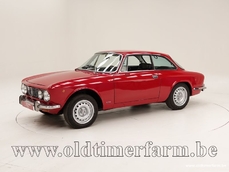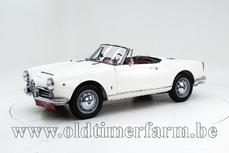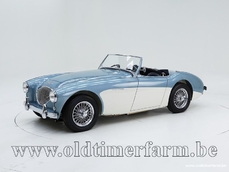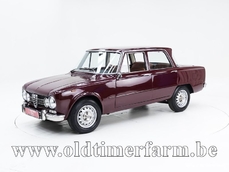Mercedes-Benz 220 W187 A Cabriolet '52 1952
General description :
Saved from eternal oblivion and meticulously restored to almost entirely original With workshop manual French; very rare! Comes with a protection cover to protect it from wintry and harsh circumstances, if necessary Post-war Mercedes-Benz at its best Comes with dozens of pictures of restoration process Only 1,278 A convertibles made White-edged tires and landau bars, very elegant The Mercedes-Benz W187 was presented in 1951 at the IAA International Motor Show in Frankfurt. By producing this luxury car based on the pre-war W136, Mercedes-Benz aimed to reestablish itself as a manufacturer of solely luxury vehicles. Thus, the W187, always sold under the model code '220' due to its engine displacement, featured a straight-six engine which was the first from Mercedes-Benz after the war, alongside a range of four-cylinder models. For four years, Mercedes-Benz produced the W187 alongside the equally high-end W186, creating a duo of flagship models, which later became a trio in 1953 with the arrival of the 300 SL. The W187 is based on its predecessor, the W136, which was also a precursor to diesel engines. Many parts of both cars are similar. The most significant exterior difference is the position of the headlights; in the W136, they were mounted on top of the fenders in a 1930s style, while the W187 chose to integrate the headlights into the flowing fenders for aerodynamics reasons. Like the W136, the W187 was available in various configurations, but only the 2.2-liter six-cylinder engine lied under the hood, which allowed Mercedes-Benz to reposition itself as a producer of high-quality and prestigious cars after turbulent war time. After World War II, the company had only produced four-cylinder engines, which did not align with their business policy and their world-famous Mercedes motto, ‘das Beste oder nichts’, or 'the best or nothing', which Mercedes-Benz strictly obeys to when building their cars. In addition to its relatively progressive external design, much can be said about the luxurious interior finish, where Mercedes-Benz leaves no doubt about being a luxury manufacturer. No expense is spared: the seats and doors are beautifully finished with classic leather, the dashboard is adorned with wooden accents and gauges, and the classic radio also takes centre stage. Avantgarde paddle shifters on the steering wheel, the elegant steering wheel itself, and the handbrake placed in a spot that only Mercedes-Benz could think of, right next to the clutch pedal – everything is meticulously placed, leaving nothing to chance and presenting the whole with imperial pride. Production of the W187 ends in 1955, a total of just over eighteen thousand cars of the four models - a saloon, a coupe, and two convertibles – were built. Mercedes-Benz 220 A In the W187 series, the 220 A serves as the convertible version. Alongside the A, there is also a B, with the only distinction being that the A has a convertible top with two side windows, while the B has four – two on each side. Unlike the B convertible, which ceases production in 1954, the A convertible is built throughout the entire production run of the W187 series, until 1955. A total of 1,278 are produced, they are scarce. Due to its elegant design and the pioneering role in Mercedes-Benz's return to producing luxury vehicles with powerful engines, the 220 A is a highly sought-after collector's item. Technical information: Body work Length (cm): 454 (179 inch) Width (cm): 169 (67 inch) Height (cm): 156 (61 inch) Wheelbase (cm): 285 (112 inch) Weight (kg): 1460 (3219 lbs) Mechanics Engine: straight-six 2195 cc front-engine Valve gear: 12 Fuel system: 1 carburettor Solex Gear box: 4-speed manual Transmission: RWD Left-steered power: 79 hp (58 kW) at 4600 t/m torque: 142 Nm at 2500 t/m Top speed: 145 km/h (90 mph)
1952 Mercedes-Benz 220 W187 A Cabriolet '52 is listed for sale on ClassicDigest in Aalter by Oldtimerfarm for €184950.
Car Facts
Car type : Car Make : Mercedes-Benz Model : 220 W187 Model Version : A Cabriolet '52 Engine size : 0.0 Model Year : 1952 Location : Aalter Vehicle Registration : Undefined
184950 €
People who viewed this Mercedes-Benz 220 W187 also viewed similar Mercedes-Benz listed at ClassicDigest
Other cars listed for sale by this dealer
About Mercedes-Benz
In the annals of automotive history, the journey of Mercedes-Benz is a tale that unfolds with the ingenuity of its founding pioneers. In the year 1886, Karl Benz crafted the Benz Patent Motorwagen, a creation that would go down in history as the world's inaugural automobile. Unbeknownst to him, this moment marked the genesis of what would evolve into the most illustrious premium car manufacturer globally. The financial underpinning of this pioneering venture, interestingly, was provided by Karl Benz's wife, Bertha Benz, demonstrating a remarkable partnership that would set the tone for Mercedes-Benz's legacy.A parallel narrative emerged not far away, as Daimler-Motoren-Gesellschaft, founded by Gottlieb Daimler and Wilhelm Maybach, entered the scene. In 1901, they unveiled their automobile under the now-famous moniker "Mercedes," meaning "godsend" in Spanish. This name was bestowed upon the car at the behest of Emil Jellinek's daughter, the distributor for Daimler-Motoren-Gesellschaft. The wheels of innovation were set in motion.
Fast forward to 1926, a pivotal year that witnessed the merger of Daimler with Benz & Cie., culminating in the birth of Daimler-Benz. The amalgamation saw the adoption of "Mercedes-Benz" as the distinguished trademark for their automobiles, fusing the legacies of two visionary entities into one.
Contrary to perceptions of conservatism, the trajectory of Daimler-Benz unfolds as a chronicle of industry firsts. From the introduction of the honeycomb radiator to the float carburetor, and the pioneering implementation of four-wheel brakes in 1924, Daimler-Benz consistently pushed the boundaries of automotive innovation. The diesel-powered Mercedes-Benz 260 D in 1936 marked the inception of diesel engines in passenger cars. The iconic Mercedes-Benz 300SL Gullwing made history as the first car with direct fuel injection, albeit the Gutbrod's tiny 2-stroke engine can claim precedence.
Safety innovations became a hallmark, with Béla Barényi's patented safety cell design in the "Ponton"-models in 1951, featuring front and rear crumple zones. The W116 450SEL 6.9 saw the introduction of the Anti-Lock Brake system (ABS), another pioneering safety feature. From the first production airbags and beyond, the legacy of "firsts" continued to be etched into the fabric of Daimler-Benz.
Over its centennial journey, Mercedes-Benz has not merely produced cars but has sculpted automotive icons. The SSKL, 710 SSK Trossi Roadster, 770K Grosser, 540K Spezial Roadster, 300SL Gullwing, w100 600 Pullman, w111 280SE 3.5 Flachkühler, w113 230SL Pagoda, w109 300 SEL 6.3, and w201 2.3-16 Cosworth stand testament to the brand's commitment to engineering excellence.
The roaring Silver Arrows, or "Silberpfeile," including the W 25, W 125, W154, W165, and W196, created a legacy of dominance on the racetrack. These machines were not merely cars; they were expressions of precision, speed, and an indomitable spirit that left their competitors in the dust.
As Mercedes-Benz marches into the future, it does so not just as an automaker but as a custodian of a legacy, a torchbearer of innovation, and a beacon of automotive excellence. The road ahead is sure to witness the continued fusion of cutting-edge technology, timeless design, and an unwavering commitment to setting new standards in the world of automobiles.
One luminary figure who left an indelible mark was Béla Barényi, often heralded as the "father of passive safety" for his pioneering work in safety engineering. His patented safety cell design, featuring front and rear crumple zones, became a hallmark of Mercedes-Benz's commitment to occupant safety, setting new standards that reverberated throughout the automotive world.
Moving through the chronicles, the collaborative genius of Wilhelm Maybach, alongside Gottlieb Daimler, laid the foundation for Daimler-Motoren-Gesellschaft. Their innovations not only birthed the first Mercedes but established a culture of relentless pursuit of technological excellence that remains integral to Mercedes-Benz's DNA.
In the post-merger era of 1926, Ferdinand Porsche emerged as a prominent figure within Mercedes-Benz. His work on the Mercedes-Benz S-Type, a supercharged race car, garnered acclaim and set the stage for a legacy that extended far beyond the marque. Porsche's impact would later extend to his eponymous company, but his influence at Mercedes-Benz during those formative years was pivotal.
As the 20th century progressed, the legendary Rudolf Uhlenhaut emerged as a key figure. Uhlenhaut, an accomplished engineer and the driving force behind the iconic Silver Arrows, played a crucial role in Mercedes-Benz's dominance in motorsports. His engineering prowess and attention to detail were instrumental in creating some of the most formidable racing cars of the era.
In the latter half of the century, figures like Bruno Sacco, the head of design at Mercedes-Benz from 1975 to 1999, left an indelible imprint on the brand's aesthetic identity. Sacco's design philosophy, characterized by clean lines and timeless elegance, shaped iconic models like the W126 S-Class and the W201 190E, solidifying Mercedes-Benz's reputation for luxury and sophistication.
The narrative would be incomplete without acknowledging the contributions of engineers like Hans Scherenberg, whose leadership in the 1970s ushered in a new era of technological innovation at Mercedes-Benz. Scherenberg's tenure saw the development of groundbreaking technologies, including the Anti-Lock Brake system (ABS) and the introduction of airbags in production cars.
